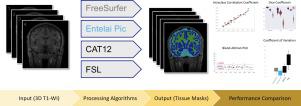Journal of Neuroradiology ( IF 3.0 ) Pub Date : 2020-11-01 , DOI: 10.1016/j.neurad.2020.10.001 Hernán Chaves 1 , Francisco Dorr 2 , Martín Elías Costa 2 , María Mercedes Serra 1 , Diego Fernández Slezak 3 , Mauricio F Farez 4 , Gustavo Sevlever 5 , Paulina Yañez 6 , Claudia Cejas 6

|
Background and purpose
There are instances in which an estimate of the brain volume should be obtained from MRI in clinical practice. Our objective is to calculate cross-sectional robustness of a convolutional neural network (CNN) based software (Entelai Pic) for brain volume estimation and compare it to traditional software such as FreeSurfer, CAT12 and FSL in healthy controls (HC).
Materials and Methods
Sixteen HC were scanned four times, two different days on two different MRI scanners (1.5 T and 3 T). Volumetric T1-weighted images were acquired and post-processed with FreeSurfer v6.0.0, Entelai Pic v2, CAT12 v12.5 and FSL v5.0.9. Whole-brain, grey matter (GM), white matter (WM) and cerebrospinal fluid (CSF) volumes were calculated. Correlation and agreement between methods was assessed using intraclass correlation coefficient (ICC) and Bland Altman plots. Robustness was assessed using the coefficient of variation (CV).
Results
Whole-brain volume estimation had better correlation between FreeSurfer and Entelai Pic (ICC (95% CI) 0.96 (0.94−0.97)) than FreeSurfer and CAT12 (0.92 (0.88−0.96)) and FSL (0.87 (0.79−0.91)). WM, GM and CSF showed a similar trend. Compared to FreeSurfer, Entelai Pic provided similarly robust segmentations of brain volumes both on same-scanner (mean CV 1.07, range 0.20–3.13% vs. mean CV 1.05, range 0.21–3.20%, p = 0.86) and on different-scanner variables (mean CV 3.84, range 2.49–5.91% vs. mean CV 3.84, range 2.62–5.13%, p = 0.96). Mean post-processing times were 480, 5, 40 and 5 min for FreeSurfer, Entelai Pic, CAT12 and FSL respectively.
Conclusion
Based on robustness and processing times, our CNN-based model is suitable for cross-sectional volumetry on clinical practice.
中文翻译:

健康对照 MRI 的脑容量量化:评估基于卷积神经网络的软件对 FreeSurfer、CAT12 和 FSL 的相关性、一致性和稳健性
背景和目的
在某些情况下,在临床实践中应该从 MRI 获得脑容量的估计值。我们的目标是计算基于卷积神经网络 (CNN) 的软件 (Entelai Pic) 用于脑容量估计的横截面稳健性,并将其与健康对照 (HC) 中的 FreeSurfer、CAT12 和 FSL 等传统软件进行比较。
材料和方法
16 个 HC 在两个不同的 MRI 扫描仪(1.5 T 和 3 T)上扫描了四次,两天不同。使用 FreeSurfer v6.0.0、Entelai Pic v2、CAT12 v12.5 和 FSL v5.0.9 获取和后处理体积 T1 加权图像。计算了全脑、灰质 (GM)、白质 (WM) 和脑脊液 (CSF) 的体积。使用组内相关系数 (ICC) 和 Bland Altman 图评估方法之间的相关性和一致性。使用变异系数 (CV) 评估稳健性。
结果
与 FreeSurfer 和 CAT12 (0.92 (0.88−0.96)) 和 FSL (0.87 (0.79−0.91)) 相比,全脑容量估计在 FreeSurfer 和 Entelai Pic (ICC (95% CI) 0.96 (0.94−0.97)) 之间具有更好的相关性。WM、GM 和 CSF 显示出类似的趋势。与 FreeSurfer 相比,Entelai Pic 在相同扫描仪(平均 CV 1.07,范围 0.20–3.13% 与平均 CV 1.05,范围 0.21–3.20%,p = 0.86)和不同扫描仪变量上提供了类似的强大的脑容量分割(平均 CV 3.84,范围 2.49–5.91% 与平均 CV 3.84,范围 2.62–5.13%,p = 0.96)。FreeSurfer、Entelai Pic、CAT12 和 FSL 的平均后处理时间分别为 480、5、40 和 5 分钟。
结论
基于稳健性和处理时间,我们基于 CNN 的模型适用于临床实践中的横截面体积测量。











































 京公网安备 11010802027423号
京公网安备 11010802027423号